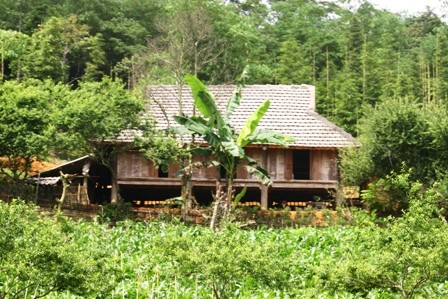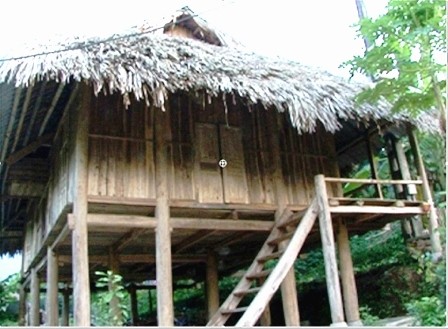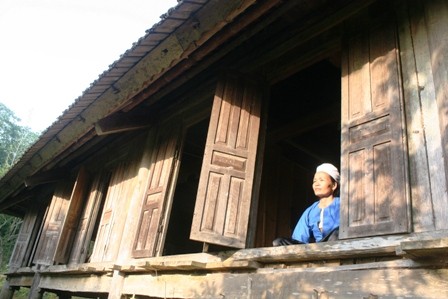(VOVworld) – The Muong have maintained their traditional construction techniques in building stilt houses - choosing an orientation, building, and decorating the house.

A Muong house often leans on the mountain (photo:vhttcs.org.vn) |
The Muong in Hoa Binh have 4 branches: the Muong Bi, Muong Vang, Muong Thang, and Muong Dong. The Muong Bi are considered the oldest branch and the cradle of the Muong culture.
The Muong Bi in Ai hamlet, Tan Lac district, still practice ancient customs, worshipping rituals, and eating and dressing habits. The stilt house of the Muong Bi is considered a museum of the everyday life. The wood house of patriarch Bui Van Khan is typical. It has wood walls and a bamboo floor. In the summer the wind blows through the interstices to cool the house, but it’s piercing cold in the winter. But Khan and many other villagers don’t want to change. “People in other places now make a wood floor. But we want to keep our tradition. In my hamlet there are 23 large stilt houses which have bamboo floors.”
 |
The stilt house is a major asset of the family which reminds people of their ancestors. The Muong carefully choose an orientation for their house which suits the land and the surrounding scenery. A good orientation will generate prosperity and luck for the owners. Khan said: “The altar is placed facing the same direction as the front window. It is the upper part of the house and the other side is the lower part. Almost all houses look southeast.”
A Muong house has two stairs. One is at the front door and one is at the back door, leading to the water tank which is convenient for the women’s housework. There is an odd number of steps which represents good luck and growth.
 |
An odd number of steps represents prosperity
|
The fire stove, which is considered the soul of the stilt house, is placed in the centre of the house. When winter comes, people gather around the fire to have a meal and talk after a hard day’s work. The house has many rooms for family members. Bui Van Hai of Ai hamlet said: “A newly married couple sleeps in the end room. Unmarried people occupy the middle rooms and the parents are in the front room. Guests stay in a separate room. When having a meal, the elderly sit at the upper area and the children sit at the lower area according to their age.”

Old people are prepared to sleep near the fire in the winter |
A Muong house has many windows which have names and special functions. The son-in-law and daughter-in-law are not allowed to sit at the windows until their parents die and they become the owners of the house. Bui Van Hai elaborates: “Every window has a name which relates to a worshiping ritual. They worship their ancestors at voong toong, the first window, and pray for their cattle at voong leo, the last window. A health ceremony for old people is organized at voong khua and a birthday ceremony for a new born baby is placed at voong coong.”
 |
| The stilt house has many windows |
The Muong often build houses in January, February, March, or May. Hai talked to us about house construction: “The owner will beat a drum to call the villagers to help on groundbreaking day. In the past our village had a rule that all families contributed materials to build a house such as bamboo wattles or wood pillars. To build a house requires 1000 bamboo wattles. 300 families in the village will contribute 300 wattles. All families will help each other like that.”
The Muong Bi in Hoa Binh continue to uphold the traditions and lifestyle of their group despite changes in the outside society.